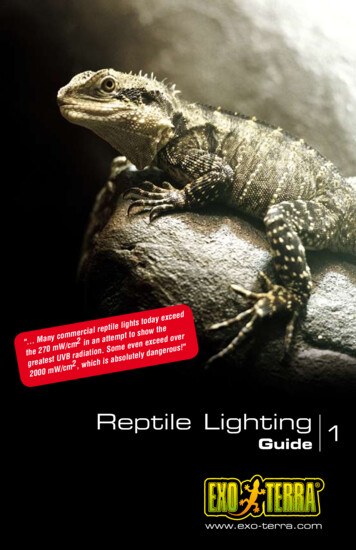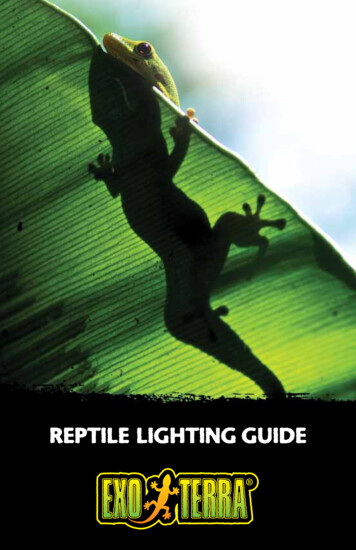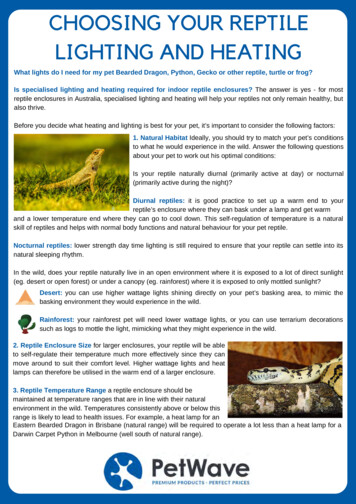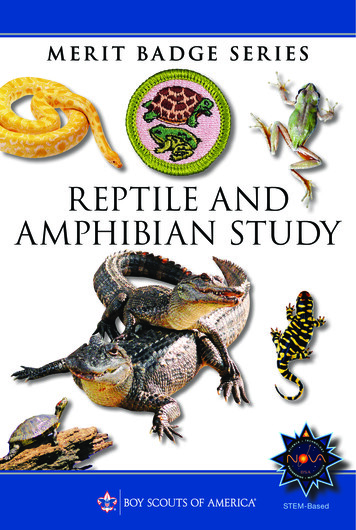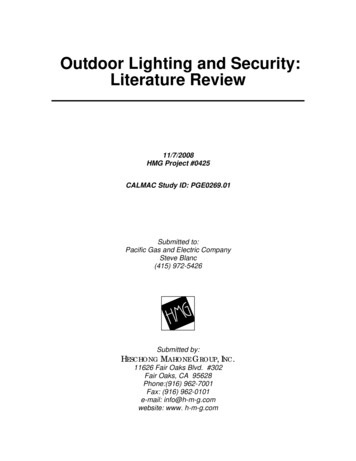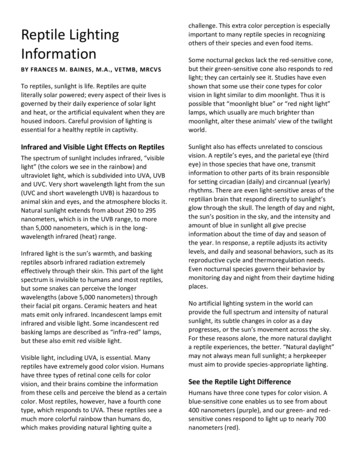
Transcription
Reptile LightingInformationBY FRANCES M. BAINES, M.A., VETMB, MRCVSTo reptiles, sunlight is life. Reptiles are quiteliterally solar powered; every aspect of their lives isgoverned by their daily experience of solar lightand heat, or the artificial equivalent when they arehoused indoors. Careful provision of lighting isessential for a healthy reptile in captivity.Infrared and Visible Light Effects on ReptilesThe spectrum of sunlight includes infrared, “visiblelight” (the colors we see in the rainbow) andultraviolet light, which is subdivided into UVA, UVBand UVC. Very short wavelength light from the sun(UVC and short wavelength UVB) is hazardous toanimal skin and eyes, and the atmosphere blocks it.Natural sunlight extends from about 290 to 295nanometers, which is in the UVB range, to morethan 5,000 nanometers, which is in the longwavelength infrared (heat) range.Infrared light is the sun’s warmth, and baskingreptiles absorb infrared radiation extremelyeffectively through their skin. This part of the lightspectrum is invisible to humans and most reptiles,but some snakes can perceive the longerwavelengths (above 5,000 nanometers) throughtheir facial pit organs. Ceramic heaters and heatmats emit only infrared. Incandescent lamps emitinfrared and visible light. Some incandescent redbasking lamps are described as “infra-red” lamps,but these also emit red visible light.Visible light, including UVA, is essential. Manyreptiles have extremely good color vision. Humanshave three types of retinal cone cells for colorvision, and their brains combine the informationfrom these cells and perceive the blend as a certaincolor. Most reptiles, however, have a fourth conetype, which responds to UVA. These reptiles see amuch more colorful rainbow than humans do,which makes providing natural lighting quite achallenge. This extra color perception is especiallyimportant to many reptile species in recognizingothers of their species and even food items.Some nocturnal geckos lack the red-sensitive cone,but their green-sensitive cone also responds to redlight; they can certainly see it. Studies have evenshown that some use their cone types for colorvision in light similar to dim moonlight. Thus it ispossible that “moonlight blue” or “red night light”lamps, which usually are much brighter thanmoonlight, alter these animals’ view of the twilightworld.Sunlight also has effects unrelated to consciousvision. A reptile’s eyes, and the parietal eye (thirdeye) in those species that have one, transmitinformation to other parts of its brain responsiblefor setting circadian (daily) and circannual (yearly)rhythms. There are even light-sensitive areas of thereptilian brain that respond directly to sunlight’sglow through the skull. The length of day and night,the sun’s position in the sky, and the intensity andamount of blue in sunlight all give preciseinformation about the time of day and season ofthe year. In response, a reptile adjusts its activitylevels, and daily and seasonal behaviors, such as itsreproductive cycle and thermoregulation needs.Even nocturnal species govern their behavior bymonitoring day and night from their daytime hidingplaces.No artificial lighting system in the world canprovide the full spectrum and intensity of naturalsunlight, its subtle changes in color as a dayprogresses, or the sun’s movement across the sky.For these reasons alone, the more natural daylighta reptile experiences, the better. “Natural daylight”may not always mean full sunlight; a herpkeepermust aim to provide species-appropriate lighting.See the Reptile Light DifferenceHumans have three cone types for color vision. Ablue-sensitive cone enables us to see from about400 nanometers (purple), and our green- and redsensitive cones respond to light up to nearly 700nanometers (red).
This melamine glass-fronted vivarium measuring 4 feet long by 2 feetwide by 2 feet tall shows appropriate lighting for chuckwallas(Sauromalus ater). The main basking area combines light from an 80watt household PAR38 tungsten flood and a 100-watt Reptile UVMegaRay SB Mercury Vapor Lamp. Another household flood lamplights the secondary basking site. Four artificial caves provide shelterin different temperature zones. PHOTO BY FRANCES M. BAINES.Most diurnal lizards, however, have a fourth conetype that responds to UVA. For example, the eyesof a red-eared slider (Trachemys scripta elegans)perceive all the colors humans recognize as well ashigher-wavelength UVA (from 350 nanometers)and low-wavelength infrared (up to about 750nanometers). This extra perception almostcertainly adds additional colors to the turtle’srainbow. Some nocturnal geckos, suchas Hemidactylus turcicus, lack the red-sensitivecone. Although they may not be able to distinguishred from green, they can certainly see it just likecolorblind humans can. Geckos have superb colorvision in other parts of the spectrum. For example,they can distinguish blues from browns inextremely dim light where humans see no color atall. See figure 4.Reptile UVB LightEver wondered why basking lizards flatten toincrease their surface area, or why tortoises andturtles bask with their neck and legs extended, orwhy shade dwellers and crepuscular species usuallyhave thinner, more translucent skin that allowsdeeper penetration of diffused and reflected light?It’s because sunlight has direct effects uponreptiles’ exposed skin.PHOTO BY FRANCES M. BAINESA reptile uses information such as light’s intensity and color, andthe length of day and night to adjust behavior to changing seasons.UVB in sunlight has a direct effect upon theimmune system in skin and may also stimulateproduction of beta endorphins, giving sunlight itsfeel-good factor. But this range of the lightspectrum is best known for its role in skin synthesisof vitamin D3. For this to occur, sunlight mustcontain UVB in wavelengths ranging from 290nanometers to about 315 nanometers. Most glassand plastics block these wavelengths, and theatmosphere also partially blocks them, so the sunmust be fairly high in the sky for significantamounts of UVB to be found in sunlight. However,even at higher latitudes, including northern U.S.
states and most of Europe, there is sufficient UVBfor vitamin D3 synthesis from midmorning tomidafternoon in sunshine from April to Septemberand from early morning until late afternoon inmidsummer (mid-May until late July).harmful nonterrestrial, short wavelength UVB).Herpkeepers can find UV Index recordings for awide range of lamps on the UV Guide U.K. website:uvguide.co.uk.A UV-transmitting skylight helps light the Komodo dragon enclosureat ZSL London Zoo in the U.K. PHOTO BY FRANCES M. BAINES.As this diagram shows, the full solar spectrum of light is importantfor reptile health. PHOTO BY FRANCES M. BAINES.Vitamin D3 synthesis in reptiles requires warmthas well as ultraviolet light. UVB converts acholesterol in the skin to pre-D3, and this isconverted into vitamin D3 very rapidly when areptile is at its optimum temperature. The vitaminis toxic in large amounts, which is one reason givingit as a supplement can be risky (always followmanufacturer instructions regardingsupplementation), but reptiles never generate toomuch D3 in their skin while basking. Natural levelsof higher wavelength UVB and UVA preventoverproduction. They convert excess pre-D3 andvitamin D3 into harmless byproducts as soon asthey start building up.Several manufacturers make UVB-emitting bulbsfor reptiles. Measuring a reptile lamp’s UV intensityat different distances is one way to assess thelamp’s value in terms of its ability to help in vitaminD3 synthesis and its safety (excess radiation can beharmful to a reptile’s skin and eyes). This UVintensity can be categorized using the UV Index,the same scale weather forecasters use, andaccurate meters designed for lamp measurementmust be used (the sensors of inexpensive UV Indexmeters designed to measure sunlight don’t registerThe maximum UV Index appropriate for eachspecies must be determined using knowledge ofthe microhabitat of the reptile in the wild. Reptilesthat stay in shade, or only bask in early-morning orlate-evening sunlight require far lower values thanspecies that bask in late-morning tropical sun.Lamp Position - All light sources should be above a reptile’s head —not to the side. PHOTO BY FRANCES M. BAINES.Reptile Outdoor and Indoor LightingIn every ecological niche, different species haveevolved behaviors and bodily characteristicsenabling them to use full-spectrum light from thesun in the most efficient way. Many reptiles benefitfrom outdoor enclosures whenever ambienttemperatures are suitable. Whether or not theyrequire direct sunlight depends upon the species,but all species require access to full shade andshelter.
Sometimes aspects of outdoor lighting can bebrought indoors. Room-sized enclosures can beequipped with skylights and windows glazed withspecial UV-transmitting acrylic or glass. Tradenames for such UV-transmitting products includePerspex, Plexiglas and Lucite (acrylics), andStarphire (low-iron glass), all of which must bespecial ordered. Even then, supplementary UVBmay be required. Heat built up by direct sunlightthrough glass must never be ignored, either.decide how much heat, visible light and UVradiation it experiences each day.Artificial Sunlight Options for ReptilesMost lizards and chelonians, and many snakes,need high levels of full-spectrum lighting, whichmust include UVB and UVA. Herpkeepers must aimto use the lamps available to provide pets withtheir specific lighting needs.Incandescent (tungsten or halogen) lamps provideexcellent heat and visible light for a basking spot,and they can be thermostatically controlled.Standard type-A household bulbs or flood lampswith a beam at least 30 degrees wide work fine.Their predominantly red-and-yellow light isdeficient in blue light and UVA, and they do notemit UVB. These complement all UVB-emittingreptile lamps, which have little red or yellow light,extremely well. Incandescent lamps connected totimers can produce a simple effect for dawn anddusk. Timers can switch them on just before, andoff just after, the UVB lamps.Does this look safe to you? The temperature of the substrate underthis basking lamp might be perfect, but the tortoise’s carapace isnearly 10 inches closer than this to the lamp. Take into account yourreptile’s height when checking temperatures. PHOTO BY FRANCES M.BAINES.Unfortunately, comparatively few reptiles incaptivity experience truly natural lighting. Most arehoused indoors and behind glass, and they relyupon artificial light to make their day. Adequatelight in captivity is best provided by emulating thereptile’s natural environment, including atemperature gradient as found in the species’microhabitat. These provisions allow the reptile to
“Daylight” fluorescent tubes are sometimes called“full-spectrum” lights, but they do not producesufficient UVB for vitamin D3 synthesis in reptiles.Some brands produce traces of UVB and a littleUVA. They can be useful for improving general lightlevels in cooler areas of a vivarium.UVB fluorescent tubes produce diffuse, low levelsof UVB resembling outdoor shade on a sunny day.They emit less visible light than other bulb types.These tubes are suitable for supplying UVB tospecies that do not bask in sunlight, such as someforest shade-dwellers, or for small enclosureswhere the heat from mercury vapor lamps wouldcause problems with the thermal gradient. Alwayscombine them with a better visible-light source.Quality tubes emit light with a UV Index betweenabout 0.5 and 1.0 (sunlight in the tropics before7:30 a.m.) at 12 inches (the usual maximumdistance suggested), and they need to be replacedevery year.UVB compact fluorescent lamps also producediffuse, low levels of UVB at basking distances.However, at close range and/or if reflectors areused, the light and UVB may be intense, makinggood positioning difficult. These lamps decay morerapidly than tubes and may need replacement aftersix months.A few brands of fluorescent lamps for reptiles, bothcompact and tube types, have been found to emithazardous shortwave UVB. These have caused eyeproblems such as photokeratoconjunctivitis. Somemanufacturers that experienced the problem saythey have addressed the issue, while others are stilladdressing it. However, if your reptile developsswollen eyes or refuses to open them shortly aftera new lamp is installed, see your herp veterinarianimmediately. You may wish to refer him or her tothis article. Lamp placement, the lamp itself and/orother factors could be responsible.Incandescents (A), “daylight” fluorescents (B), UVB fluorescent tubes(C), mercury vapor lamps (D) and UVB metal halide lamps (E) areamong the bulbs used in reptile husbandry. PHOTO BY FRANCES M.BAINES.Mercury vapor lamps vary in quality and UVBoutput. These lamps also produce significant heat,and they cannot be thermostatically controlled, sothey are most suitable for large enclosures. Be sureto follow the manufacturer’s guidelines and
instructions for proper lamp placement anddistances. Several mercury-vapor-lamp types areavailable. Inexpensive spot lamps with clear-glassfaces may produce extremely narrow, hazardousbeams of intense UV light and are best avoided.Flood lamps have much wider beams, and they areideal for reptiles that naturally bask in the sun.They create directly below the lamp a zone ofbright light and UVB resembling a small patch ofsunlight. Brands vary in their UV Index. Recordingsrange from about 2.0 (full tropical sun before 8:30a.m.) to 7.0 (full tropical sun between 9 a.m. and10 a.m.) within the basking area.Metal halide lamps are rapidly gaining a place in, orrather over, the vivarium. Like mercury vaporlamps, metal halides are most suitable for largeenclosures and cannot be used with a thermostat.Most do not produce UVB. “Daylight” versions witha color temperature between 5,500 and 6,500Kelvin are the best choice for creating the look ofsunlight. Used with care, these lamps are superbfor simulating bright daylight in a large vivariumwhen combined with a UVB lamp. However, theyrequire an external ballast, and positioning them iscrucial. At close range the visible light is extremelyintense, and the lamp must never be looked intodirectly. Manufacturers are developing UVBemitting metal halides designed specifically forreptiles, and early test results look promising.Although the UV Index range can vary dependingupon the brand, some sample lamps I tested for UVGuide U.K. were emitting light with a UV Indexbetween 2.5 and 5.0 (full tropical sun between 8:30a.m. and 9:30 a.m.) at 18 inches. shelters, and basking areas, so they can select their preferenceslike they would in the wild.UVB, UVA, visible light and heat go together. Because vitaminD3 synthesis in reptiles occurs only in warm skin exposed toUVB, ideally a UVB lamp needs to be over the basking area.Pairing the UVB source with the basking lamp is always awinning combination.Like the sun, lamps should be overhead. Reptiles have eyebrowridges, and some have upper eyelids, for a reason: They shadethe surface of the eye. All light sources should always bedirectly above a reptile’s head, not to the side. Lights shiningsideways into its eyes are stressful (think of driving a car towardthe setting sun). Also, intense visible light, as well as UVA andUVB, can seriously damage eyes.Keep a respectful distance. In the author’s opinion, no lamp ortube should be closer than six inches from the reptile, evenwhen positioned directly overhead. Heat lamps usually requiremuch greater distances than this. At close range many lampsare frankly dangerous. Most quality UVB lamps have minimumand maximum recommended distances, and these must becarefully observed.No spots please! Basking spots should be basking zones. Areptile’s whole body must fit within the high-temperature,brightly lit basking area. Flood lamps are essential. Narrow spotlamps may only heat a small patch of skin, which may becomedangerously hot while the rest of the body remains cold. Thehapless creature may stay where it is, trying to warm further,and sustain thermal burns.Always double-check your temperatures. It is vital to check thetemperatures reached under a lamp. Take into account theheight of a lizard’s head and shoulders, or a chelonian’scarapace, when doing this.Allow reptiles to set their patterns. Reptiles rely upon a distinctday and night to set their circadian rhythms. Day must be light;night must be dark. Use timers to provide the correctphotoperiod for the species. If nighttime heat is required,ceramic heaters or heat mats mounted on a rear wall are moresuitable than night lamps.FRANCES M. BAINES, M.A., VetMB, MRCVS, is a veterinarian researching therequirements of reptiles for visible and ultraviolet light. She writes onuvguide.co.uk and, with colleague Andrew Beveridge, independently assessesreptile lamps worldwide. She is currently an advisor to the Reptile andAmphibian Working Group of the British and Irish Association of Zoos andAquariums.To reptiles, sunlight is life. Artificial sunshine is notideal, but there are now many combinations oflamps, bulbs and tubes available. When used withcare and sensitivity, they will go a long way towardmeeting the needs of all reptiles in captivity.Reptile Lighting Advice Trust your reptile to know what it needs. Reptiles are extremelycompetent at deciding how much heat, visible light andultraviolet radiation they need at any given time. Captivereptiles need a sufficiently large, species-appropriatemicrohabitat with suitable heat, light and UVB gradients,13941 Elmore RoadLongmont, CO 80504303-776-2070www.corhs.org
Reptile Lighting Information BY FRANCES M. BAINES, M.A., VETMB, MRCVS To reptiles, sunlight is life. Reptiles are quite literally solar powered; every aspect of their lives is governed by their daily experience of solar light and heat, or the artificial equivalent when they are housed i
